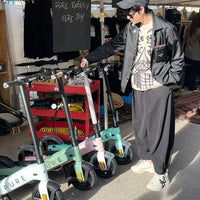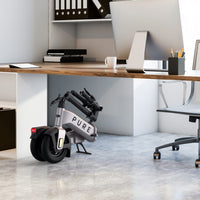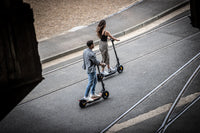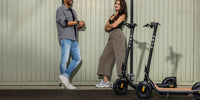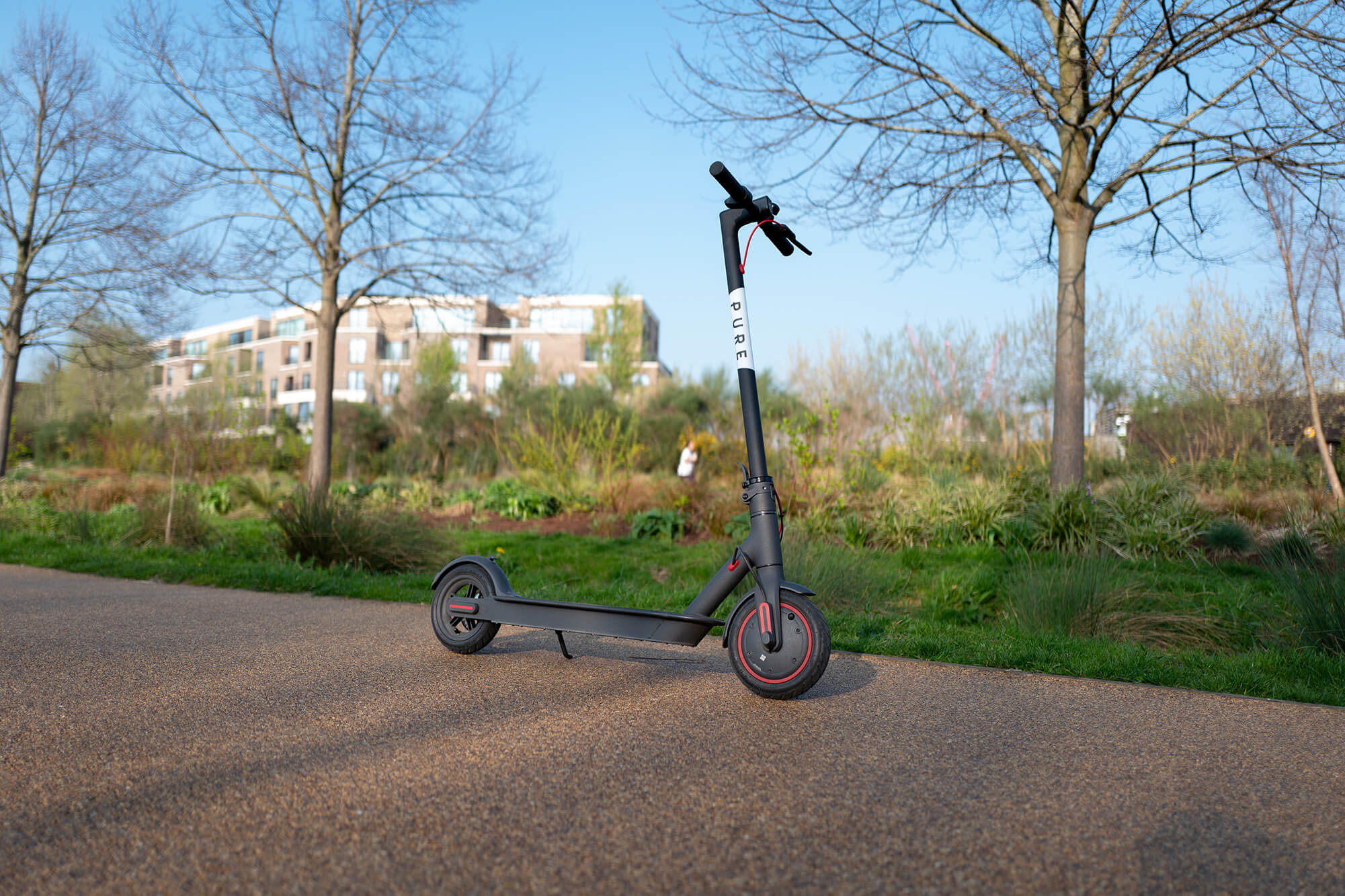
A comprehensive guide to buying an electric scooter
Electric scooters are offering people a way to travel up to five times quicker than walking while being environmentally friendly, fun and very low cost. And, unlike a bicycle, you’re not sweaty when you arrive!
With more and more people moving towards buying an electric scooter it’s important to know what to look for.
Speed, size, weight, range, reliability and cost are just a few of the factors you need to take into account when making your decision. In this guide we explain everything you need to consider to ensure you pick the best e-scooter for your needs.
Here’s what we cover in this article, feel free to click on one of the heading links to jump to the most relevant section for you:
- Quality of ride
- Motor power & hill climb ability
- Water-resistance
- Maximum load
- Range
- Speed
- Reliability
- Size & weight
- How to find an electric scooter for the best price
- How much do electric scooters cost?
- Recommended accessories
- Where to buy an electric scooter? Why Pure Electric?
Quality of ride - how comfortable should your ride be?
If you’re unsure how to buy an electric scooter then researching the quality of ride is a good place to start.
The ride quality of some e-scooters is so bad that they can’t be ridden for more than 1 mile on anything less than a perfect surface. These e-scooters look great on a web page, but many people stop using them because they are ‘bone shakers’.
There are a number of factors that affect the ride quality:
Wheel size
We strongly advise that you avoid wheels less than 10 inches diameter. Smaller wheels give a rougher ride and are more susceptible to getting stuck in potholes.
As a rule, you need large wheels with air in your tyres. If you are going to do a lot of off-road riding you will need fat treaded tyres and suspension.
View our range of scooters with 10-inch wheels here
Solid or air-filled tyres
Tyres come in two varieties: pneumatic (air-filled) and solid rubber (airless).
Air-filled tyres give you a better ride - they have the advantage of shock absorption and a much better handling but are prone to punctures and require maintenance.
If you opt for air-filled tyres we strongly recommend you also purchase ‘puncture protection fluid’. Apply this before your first ride and you may never need to change your tyres at all. Here’s a video on how to insert puncture prevention fluid.
You will also need to regularly check your air pressure and top it up when it’s low. Correct tyre pressure is vital for safety, braking effectiveness and grip. Under-inflation will cause wear, halve your battery range, stop you from reaching those top speeds and even make you more susceptible to punctures. View our range of e-scooter pumps here.
Here’s a guide on how to fix an electric scooter puncture.
E-scooters with solid tyres require virtually zero maintenance and offer a solution to punctures if you are regularly riding where there is a lot of glass, thorns or nails.
The trade off with a low-maintenance solid tyre is that they aren’t as smooth to ride, so you will feel more bumps and vibrations.
For more information read our full guide on air-filled versus solid tyres.
Suspension
Suspension on an e-scooter works the same as a car, smoothing out bumps and shocks from the ground. Think about if you’re going to be riding off-road or on rough terrain and if so, suspension might be a key consideration when looking to buy an electric scooter.
Without it you will get vibration in the handlebars which can be uncomfortable on longer rides – and where’s the fun in that?
An e- scooter with large, air-filled tyres without suspension will give a smoother ride than an e- scooter with solid tyres and suspension.
If you want an off-roader that sails over rougher terrain, strongly consider buying an electric scooter with quality suspension. Suspension can either be attached to the front, rear or both wheels.
Brakes
Your safety should always come first, and brakes are important when picking an electric scooter.
There are 3 main types of brakes on electric scooters:
1. Electric/regenerative brakes
These are low maintenance but less effective at stopping you quickly. If you are travelling at 15+mph and need to stop quickly these will be the least effective.
2. Disc brakes and drum brakes
Drum brakes are enclosed inside the wheel hub and are generally lower maintenance than other braking types and have consistent performance in wet conditions.
Disc brakes have the most stopping power and are lighter than drum brakes which helps to lighten the overall load for extra speed.
While drum and disc brakes are the best of all they will wear out over time and will eventually need to be serviced, just like a car.
3. Foot brakes
Foot brakes are activated by pushing your foot down on the rear mud guard. Unless you are used to using a kid’s scooter, this takes time to master. They have slightly more stopping power but are not as comfortable to use or effective as drum or disc brakes.
Tip: make sure you service your electric scooter regularly to keep it in full working order. Looking after your scooter properly is important.
Motor power & hill climb ability

An electric scooter motor has an average ‘rated’ power and peak power output. The higher the motor’s wattage, the more power it can produce bringing improved acceleration and hill climbing ability.
Most ‘budget e-scooters’ start at 250 watts and reach top speeds of 15mph. These models won’t be able to climb hills and will likely struggle to reach their top speed if you weigh more than 80 kilograms.
We recommend that you upgrade to a model that rates with at least 350 Watts and that you consider powering up further from there if you want to tackle hills regularly or if you are above average size.
That’s why we built the Pure Air electric scooter which has a rated motor power of 500 Watts and only costs £449.00. You can also purchase our Pure Air Pro at £599 which also has a 500W rated motor but has almost twice the range, or our entry-level Pure Air Go which costs £349 and has a 350W rated output from its motor.
Water resistance
It’s a little known fact that most electric scooters are not waterproof.
Some of the largest e-scooter manufacturers are Chinese so they build their scooters for the Chinese climate.
As a result, most e-scooters on the market will potentially stop working if you ride them on wet surfaces, through puddles or in the rain. What’s more is hidden in the fine print of many e-scooter's warranties is that getting them wet will invalidate the warranty, so you'll have to pay for the replacement yourself.
We have heard countless stories of customers trying to return Xiaomi scooters after water damage only to be told their warranty does not cover it.
If you want to ride when it is wet (a frequent occurrence as we all know in the UK) your best bet is to choose a waterproof scooter.
When building our Pure e-scooters we made sure they are waterproof, to give people a viable option for riding their scooters all year round in the UK weather.
Maximum Load

Not all electric scooters are built to carry the same load and you should factor this into your decision making.
E-scooters designed for Europe tend to have a maximum load of 100kg. A lot of people who weigh over 100kg ride these e-scooters every day. However, you must be warned that this will invalidate your warranty and could be dangerous.
If you’re riding an e-scooter that isn’t suitable for your weight it's highly likely that your performance will be hampered as well as your safety. Riding an e- scooter in this way will mean you are unlikely to reach the top speeds the vehicle claims as well as struggling more with hills.
Pure Electric’s e-scooters have been designed with different body types in mind and are capable of carrying up to 120kg of load.
Range
It is important to note that the manufacturers' quoted ranges for electric scooters are generally best-case examples.
Like speed, most are based on a light person (70kg) riding on smooth, flat, straight surface, with a new battery.
Be aware that cheaper e-scooters have cheaper batteries and the amount of charge they can hold diminishes with every charge.
Most e-scooters have a range of 15 to 20 miles. 20 to 30 miles is also fairly common and some more premium (expensive) models can have ranges of up to 40 or even 50 miles.
A longer range requires a bigger battery, this is also worth considering too as it will make the e-scooter heavier and will also increase the price tag.
In our experience, an e-scooter with a range of 25-30km is perfect for most daily riders, this will allow you to travel an average distance of 15 miles before needing to recharge.
Our new Pure Air Pro has a range of 31 miles/50 km - take a look at its full spec here.
Speed - how fast do electric scooters go?
Most electric scooters have top speeds of 15mph and for many this is more than enough to feel the buzz and get you smiling - trust us, 15mph on a scooter feels an awful lot faster than 15mph in a car!
There are other models that go up to around 18mph, but if you really want to feel the wind in your cheeks there are a few models that top out at a hair-raising 40mph.
It’s worth bearing in mind, however, going that fast on a machine with relatively small wheels can be extremely dangerous. It would be very easy to come off or lose control over uneven ground at those speeds.
It’s also important to bear in mind that the fastest electric scooters require bigger batteries and more powerful motors which are generally a lot more expensive.
E-scooter speed is determined by several factors including motor power, rider weight, your tyre pressures and the terrain you ride on.
Manufacturer’s quoted electric scooter speeds are generally based on a 70kg person using a flat, smooth surface with correctly inflated tyres. People tend to get a little hung up on electric scooter top speeds, but our advice is not to chase maximum speed. A speed of about 15mph is ideal. For context, average walking speed is 4mph, average car travel speed in London is 7mph and average cycling speed for commuters is 14mph.
Warning: always wear a helmet when riding your scooter at any speed. E-scooters are safe to ride, but accidents can still happen.
Reliability
Electric scooters are still a relatively new product category. Our advice is to stick to the large manufacturers. We have heard of some electric scooter manufacturers who have had up to 30% with faults (obviously we would not stock these products)!.
Two main factors need to be considered in this area:
Warranty
Will the company be around in the future to honour it? Going with established companies should give you peace of mind.
If you need to use your warranty, where will you need to send your e-scooter? We have heard horror stories of people having a minor fault and needing to send their e-scooter back to China to be fixed. This takes months and can cost a lot of money. We suggest you only purchase a UK-spec scooter, covered by a UK warranty.
Here’s more information on electric scooter warranties.
Fakes and cheap Chinese imports
There are a lot of cheap e-scooters being imported from China. These often look the part, but cut quality (cheap wheel bearings, battery problems, etc) and are usually unsafe.
The fakes are hard to spot when purchasing online, but the quality received tends to be terrible. You should only buy from trusted UK suppliers using UK stock.
Tip: make sure you service your electric scooter regularly to keep it in full working order. Looking after your scooter properly is important.
Size & weight
We recommend that people consider whether the e-scooter is the right size for them while riding, and if it is small enough to store conveniently when folded down.
A folded down scooter should be small enough to store easily, but not all e-scooters fold so it’s worth checking before you buy, especially if you have limited storage space at home.
It is also important to consider how far you might have to carry your e-scooter at the beginning or end of your journey, meaning you need to take the e-scooter weight into consideration as well.
Concerned an electric scooter you are interested in might be too heavy? Check out this electric scooter bag that will make your scooter much easier to carry.
Tip: some scooters have folding handlebars which make them even smaller and extra compact.
How to find an electric scooter for the best price
In addition to the advertised retail price of your chosen e-scooter, there are a number of cost factors to consider:
Finance available
Finance options may make your e-scooter of choice more affordable by spreading the payments across a period of time.
We offer two different finance options on our e-scooters: you can either split payment over three equal instalments interest-free or you can split payments equally over 3, 6, 12 or 24 months interest-free for the first 6 months.
Find more information about electric scooter finance here, in our informative guide.
Import duty
A few companies are currently quoting very low prices for e-scooters, but they are not being transparent with the total costs.
There have been cases where the seemingly cheap e-scooter has become stuck in UK customs and the customer has had to pay around 30% of purchase cost (in VAT and import Tax) before receiving their product.
Postage
Some reputable retailers offer free delivery, but this is not always the case and postage can be very expensive. Postage is not always listed on product pages, be sure to check carefully!
How much do electric scooters cost?
Most adult e-scooters tend to fall into one of three categories: budget e-scooters, premium e-scooters and high-performance e-scooters. These types of scooters range from around £300 all the way up to £1,500.
There will always be variation between models but in our experience, quality improves with price. In terms of performance, we believe you really do get what you pay for.
Budget e-scooters
This category is most popular with first-time riders, mainly because budget e-scooters usually fall within the £300 - £500 price bracket. They are great for travelling shorter distances, have a reasonable range and suitable build quality.
However, these e-scooters tend to have low-powered motors compared to the higher- end models, usually rating at around 250W, which will make them feel slower - particularly in areas with steeper hills where you might have to even get off and walk your e-scooter up the hill.
Unsatisfied with the budget offering currently available on the market, our engineers here have built the Pure Air Go, an entry-level scooter that packs an average motor power of 350watts and can carry a load of 120kg.
Tip: most e-scooters under £250 are not recommended for anything other than light recreational use. At this price point expect under-powered motors, low- capacity batteries, weaker brakes and cheaper build quality.
Premium e-scooters
These fall between £550 and £900 and typically add suspension, larger motors, bigger batteries and better brakes to their portfolio of features.
Consequently, your ride will be more comfortable, safer and the battery will last longer so you won't get stuck.
Pure Electric’s premium scooters include: the Pure Air, which has a 500W motor, class-leading hill-climbing ability, a 30km range and a max carry load of 120kg; and the Pure Air Pro which has the same spec coupled with a 50km range
High-performance e-scooters
These tend to start at £1,000+ and are the highest performing in every category except portability. They sometimes excel in terms of ride quality, braking distance, hill climbing ability, power, speed and acceleration.
With huge, sometimes dual motors you can reach hair-raising speeds of up to 40mph. They carry high quality suspension and hydraulically- activated disc-brakes for improved stopping at fast speeds.
These also tend to be the only e-scooters capable of riding off-road due to their larger tyres. If you’re looking for an e-scooter that seriously delivers on off-road fun factor, then without a doubt this the class you should be looking at.
Accessories we recommend
- Helmet: your e-scooter will be going as fast as a bicycle, so we strongly recommend always wearing a helmet. Shop electric scooter helmets here.
- Lock: your e-scooter is a valuable item and having a small portable lock will ensure its security. Shop electric scooter locks here.
- Phone holder: allows you to concentrate on riding without holding your phone, and use your phone as an extended display with some models. Shop electric scooter phone holders here.
- Puncture protection fluid: if you have air-filled tyres, it’s is worth using puncture protection fluid to reduce the risk of punctures. Shop puncture protection fluid here.
- Lights: extra lights can be attached to your e-scooter for safer night riding and visibility. Some electric scooters have built-in lights, some have reflectors. It is an easy upgrade to put state-of-the-art bicycle lights on your e-scooter if you are going to do a lot of night riding. Shop electric scooter lights here.
Where to buy an electric scooter - why Pure Electric?
We are a UK-based e-scooter specialist providing independent advice on a range of what we believe to be the best available e-scooters.
Unlike some UK based retailers, we hold stock and offer free delivery, so you won’t have to wait 30 days to receive your purchase.
We also offer finance options in the UK to help spread the cost of your purchase.
We have a team of industry experts dedicated to providing you with the best advice, best products, best service and best value.
Furthermore, because we now build our own e-scooters, we know exactly what makes an e-scooter great for our riders. We design in the UK for the UK, meaning our e-scooters are designed for the UK weather, because many other e-scooters aren’t designed to be waterproof and can’t be ridden in the rain.
Pure scooters are also available in over 65 Currys stores across the UK and Ireland, so you can see the e-scooters up close before purchasing. We also offer flexible finance options. Find a store here.

